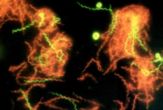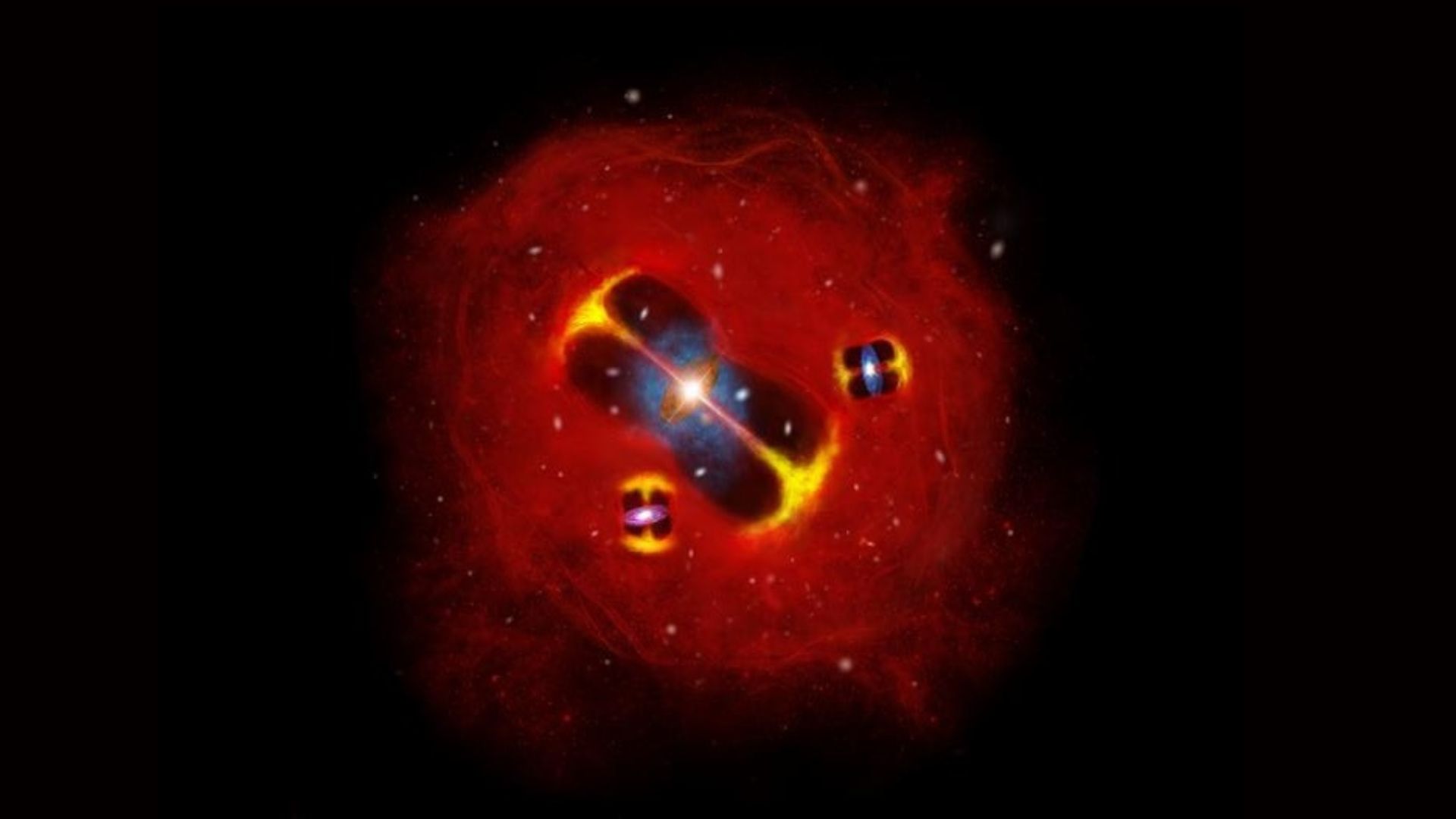Wild Things: The Most Extreme Creatures

Extremophilic microbes are a wild bunch. They can be found thriving in some of the most hostile environments imaginable - swimming in near-boiling water, eating rocks, lounging in sub-zero temperatures, and hanging out where radiation levels rival nuclear reactors.
They're tougher than duct tape, boldly going where humans dare not and cannot.
Extremophiles are also a multimillion dollar-a-year business - some of them are employed to eat oil and help clean up spills. Others have important applications in medical research. But for many scientists, these hardy microbes are interesting because they suggest the potential for life on other planets.
Recent discoveries have greatly expanded the range of these wild things. Here's a census of small creatures living in some of the worst conditions imaginable.
Needs more salt
Microbial extremophiles have recently been discovered thriving in the extremely hostile environments in the depths of the Mediterranean Sea.
Would you live here? Mono Lake is like Mars, and it is inhabited. Bizarre Creature in Idaho Raises Prospects for Life on Mars Titan: A World of its Own
At nearly 2.5 miles (4 kilometers) below sea level, with salt concentrations ten times higher than seawater, pressure 400 times greater than atmospheric pressure, and a lack of oxygen to boot, the conditions these microbes thrive in are some of the most hostile environments on Earth.
Get the world’s most fascinating discoveries delivered straight to your inbox.
In the Jan. 7 issue of the journal Science, researchers working on the European Biodeep project reported the discovery of new microbes in the anoxic basins, or 'brine lakes', located off the coast of Sicily.
It is these types of conditions, particularly the high concentrations of magnesium chloride, that have scientists imagining what the environments of other planets might consist of, and whether they contain life.
"Ascertaining the nature of the subsurface on other planets is tricky, but there is growing evidence for hypersaline environments of Mars and Jupiter's moon, Europa. Indeed, Europa is believed to have a subsurface ocean rich in magnesium salts," Terry McGenity, the lead scientist of the University of Essex group working on the Biodeep project, told LiveScience.
Since light cannot penetrate water of this depth, there are no photosynthetic bacteria in the basins. Most of the organisms the Biodeep workers have found reduce sulfates to run their metabolism.
Some of the microbes McGenity's group found were completely unknown; including a new group of Archaea they have named MSBL-1. McGenity speculates that these microbes are methanogens because they are related to methane producing Archaea and no other methane-producing microbes were found in the basins, which are abundant with methane.
The newfound microbes from the bottom of the Mediterranean. Credit: University of Essex
The European Mars Express mission detected hints of methane in Mars's atmosphere last year, and some astrobiologists have speculated that the methane could be a by-product of extremophilic methanogens or some other form of microbial life.
Hydrogen-fueled
Another recent extremophile study discovered microbes in the hot springs of Yellowstone National Park using hydrogen as their primary fuel source, refuting the popular conception that sulfur is the main source of energy for microbes living in thermal features.
The research was designed to find the main source of energy of microbes living in hot springs with temperatures over 158 degrees Fahrenheit (70 Celsius), a temperature too high for photosynthesis.
"It was a surprise to find hydrogen was the main energy source for microbes in hot springs," said University of Colorado researcher Norman Pace, who led the team.
Pace's colleague John Spear, lead author of the study published in January's online edition of the Proceedings of the National Academy of Sciences, speculated about what the discovery of hydrogen fueled microbes means for life on other planets.
Studying an Antarctic Lake to Prepare for Europa
"Hydrogen is the most abundant element in the universe," Spear points out. "If there is life elsewhere, it could be that hydrogen is its fuel."
Beat the heat
Other tiny critters prefer the cold.
Hiding beneath sheets of ice in Siberia and Antarctica are microbes called pyschrophiles or psychrotrophs. They consist mostly of bacteria, fungi, and algae, thrive in freezing temperatures ranging from 23 to 68 degrees Fahrenheit (-5 to 20 Celsius).
In addition to being cold, the environments that these microbes are found in are sometimes at tremendous depths - sometimes over two miles (3.2 kilometers) below the surface.
Pyschrophiles help us clean up arctic oil spills. They also turn our milk sour. There is a good chance, scientists say, that extraterrestrial life could be similar to this class of microbes. In a solar system where many of the planets -- including Mars -- have large ice deposits and colder temperatures in general, pyschrophiles might thrive.
Undersea hot spots
Rising as high as 15 stories off the ocean floor at depths of 7,000 feet (2,100 meters), hydrothermal vents that spew acidic, mineral rich water are the places to be - if you can stand the heat. The water coming out of the vents can reach temperatures as high as 750?F (400?C), but that's just fine to undersea thermophiles.
The mineral-munching microbes living around these volcanic "chimneys," which are so deep no sunlight can reach them, give yet another view of what life could be like on another planet, where lack of sunlight would hinder organisms relying on photosynthesis as their energy producing mechanism.
A number of the planets and moons in our solar system are covered in ice, but scientists speculate that below some of that ice are liquid oceans. If there is also volcanic activity on those ocean floors, it is possible that similar hydrothermal vents could be growing there as well. Although it is nearly impossible to know whether there is life in those oceans, at least an environment that we know organisms can live in could be present.
Under pressure
A sediment sample recently drudged up from Challenger Deep, the deepest part of the Pacific Ocean, was abundant in single-celled protists called foraminifera. Researchers were surprised to find these soft-shelled critters at depths of nearly 7 miles (11.2 kilometers), where the pressure is 1,100 times greater than at the surface.
Organisms Found in Deepest Part of Ocean
"I am very surprised that so many very simple, soft-shelled foraminifera are dwelling at the deepest part of the ocean," said Hiroshi Kitazato, of the Institute for Research on Earth Evolution at the Japan Agency for Marine-Earth Science and Technology.
Kitazato suggests that the deep trenches, where the creatures can feed on bits of sunken organic matter, may provide a refuge for the foraminifera.
The fossil record of foraminifera is over 550 million years old. In last week's issue of the journal Science, Kitazato suggested that these new creatures probably represent the remnants of a deep-dwelling group that was able to adapt to high pressures.
The rest of the wild bunch
It's a hard rock life: Endoliths and Hypoliths are two types of extremophiles that live inside rocks or between the mineral grains. Endoliths have been found over 2 miles below the Earth's surface, and if they can stand the heat, they could dwell much deeper. Early observations show that they feed on surrounding iron, potassium, or sulfur. Water is scarce at these depths, and this slows down the procreation cycle of the organisms - some reproduce only once every 100 years!
Biotechs Mine Bacteria for Industrial Use
Hypoliths are photosynthetic organisms, so the rocks they live in must be translucent, like quartz. Hypoliths are commonly found in extreme deserts in cold climates, such as on Cornwallis Island and Antarctica. Their translucent homes provide them with many comforts, such as trapped moisture and protection from ultraviolet rays and harsh winds.
Hot and hotter: Hyperthermophiles are organisms that prefer temperatures above 140 degrees Fahrenheit, some even as high as 250?F (121?C), although those have trouble reproducing. The hardiest of the 50 known species are those living near hydrothermal vents - these require temperatures of over 194?F (90?C) to live. In addition to being heat resistant, many hyperthermophiles can withstand other environment stresses, such as high acidity and radiation.
One thermophile, Thermus aquaticus, produces a DNA polymerase enzyme that is widely used in molecular biology research for use in high temperature polymerase chain reactions used to replicate DNA.
Mightier than a cockroach: Toxitolerant organisms can withstand high levels of damaging agents. They can be found swimming around in benzene saturated water or in the core of a nuclear reactor.
A Yellowstone hot spring. Credit: USGS Your Ancestors May Be Martian
One species of bacteria, Deinococcus radiodurans, can withstand a 15,000 gray dose of radiation - 10 grays would kill a human and it takes over 1,000 grays to kill a cockroach. Extraterrestrial life forms would most likely need to possess similar tolerances to radiation, as the atmosphere on other planets, or lack thereof, filters out much less radiation than Earth's.
On a diet: Oligotrophic bacteria survive in, and in some cases prefer, environments that are low in nutrients. They have evolved metabolic processes that allow them to produce their own sulfur and phosphorus and they feed on their own organic waste.
While there is no evidence for life beyond Earth, information about extraterrestrial environments combined with the discoveries of life in places on our planet thought to be inhabitable keeps scientists optimistic.
"If it works this way on Earth, it's likely to happen elsewhere," says Spear, the University of Colorado scientist. "When you look up at the stars, there is a lot of hydrogen in the universe."
Image at top of page: A fluorescent stain renders green the newfound living, corkscrew-shaped Spirochaeta americana from California's Mono Lake. Green spots are spheroplasts, enlarged due to weakened cell walls. Reddish areas are dead cells. Credit: NASA/University of Alabama


